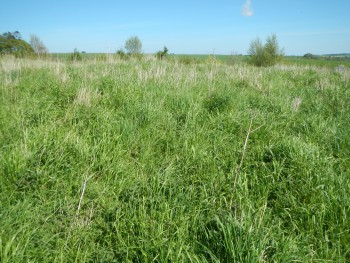- Navigation:
- Back to the Corpus index page
- RSS
Horndean / Howden Parish Church
Horndean churchyard, possible location of church
- Dedication: unknown
- Diocese of St Andrews
- Deanery of Merse
- NT 90504 49596
Summary description
The church passed out of use soon after the Reformation; no more than slight turf alignments indicate its site.
Historical outline
Dedication: unknown
The lands of Horndean are mentioned shortly before 1120 in a memorandum from Earl David (the future King David I) as the subject of a dispute between the monks of Durham and the earl’s free tenants in Horndean. A judgement arising from that dispute simply gave the monks of Durham all things that the charter in their favour issued by King Edgar (1097-1107) had bestowed on them.(1) It does not appear that the church was amongst the properties or rights that Edgar’s charter had conveyed to them.
The lands of Horndean were in the possession of the de Vieuxpont family in the second quarter of the twelfth century, and shortly after 1164 William de Vieuxpont granted the church to the monks of Kelso.(2) The gift was confirmed by his son and grandson into the thirteenth century.(3) Between 1198 and 1202 Bishop Roger de Beaumont of St Andrews confirmed Horndean to the abbey, along with twelve other churches, in proprios usus, but in the time of Bishop David de Bernham (1240-53) it was agreed that both parsonage and vicarage revenues could be annexed to Kelso.(4) The new settlement, made on account of the supposed powerty of the abbey, permitted the monks to serve the church only through ‘a suitable clerk’ rather than with a vicar or chaplain. As a consequence, the church is not listed in the rolls of the papal tax-collector in Scotland in the mid-1270s, its taxation being included within the overall figure for Kelso Abbey, and the only subsequent medieval record of the church is a note of its consecration by Bishop David on 4 April 1243.(5) It remained so annexed at the Reformation, when it was recorded that the parsonage and vicarage lay with Kelso, set for £20 and for victual, while the vicarage was valued at £13 6s 8d.(6)
Notes
1. The Charters of David I, ed G W S Barrow (Woodbridge, 1999), no.11.
2. Liber S Marie de Calchou (Bannatyne Club, 1846), no.321 [hereafter Kelso Liber]. William de Viewpont’s possession of Horndean was confirmed in King William’s court in 1165x1170: Regesta Regum Scottorum, ii, The Acts of William I, ed G W S Barrow (Edinburgh, 1971), no.84.
5. A O Anderson (ed), Early Sources of Scottish History, ii (Edinburgh, 1922), 523 [Pontifical offices of St Andrews].
6. J Kirk (ed), The Books of Assumption of the thirds of Benefices (Oxford, 1995), 224, 232, 237.
Summary of relevant documentation
Medieval
Synopsis of Cowan’s Parishes: Church granted to Kelso by William de Viponte (1147x64). The parsonage and vicarage were annexed by the mid-13th century, with the cure served by a chaplain.(1)
Mackinlay suggests that the church was dedicated to the Holy Rood.(2)
[No pre-Reformation references to the church]
Post-medieval
Books of assumption of thirds of benefices and Accounts of the collectors of thirds of benefices: The Parish church parsonage and vicarage with Kelso, set for £20 and for victual; vicarage £13 6s 8d.(3)
[Union with Ladykirk sometime post or even pre-Reformation; parish church at Ladykirk. No reference to surviving church fabric in old parish of Horndean (probably united to Ladykirk 1600)]
Notes
1. Cowan, The parishes of medieval Scotland, 83.
2. Mackinlay, Scriptural Dedications, p. 362.
3. Kirk, The books of assumption of the thirds of benefices, 224, 232 & 237.
Bibliography
Cowan, I.B., 1967, The parishes of medieval Scotland, (Scottish Record Society), Edinburgh,
Kirk, J., 1995, The books of assumption of the thirds of benefices, (British Academy) Oxford.
Mackinlay, J.M, 1910, Ancient Church Dedications in Scotland. Scriptural Dedications, Edinburgh.
Architectural description
The church of Horndean, which was also known as Howden, was granted to the Tironensian abbey of Kelso by William de Veteriponte at a date between 1147 and 1164, and in the mid-thirteenth century Bishop de Bernham permitted both the parsonage and vicarage to be annexed, with the cure served by a chaplain.(1) That same bishop carried out a dedication of the church on 4 April 1243.(2)
The church had passed out of use by around 1576,(3) becoming absorbed into the parish of Ladykirk. Within the isolated and heavily overgrown churchyard, slight traces of a rectangular building indicated by parallel turf alignments suggest it had dimensions of 18 by 8 metres.
Notes
1. Ian B. Cowan, The Parishes of Medieval Scotland, (Scottish Record Society) 1967, p. 83.
2. Alan Orr Anderson, Early Sources of Scottish History, Edinburgh, 1922, vol. 2, p. 523.
3. James Robson, The Churches and Churchyards of Berwickshire, Kelso, 1896, p. 148.
Map
Images
Click on any thumbnail to open the image gallery and slideshow.





